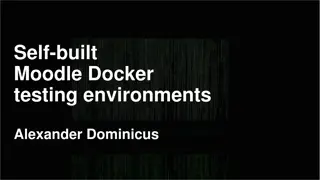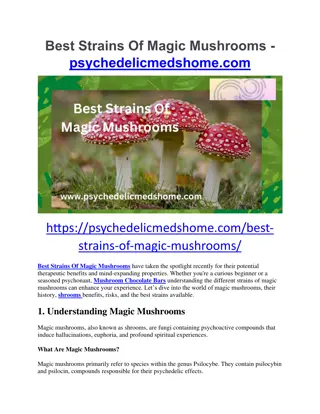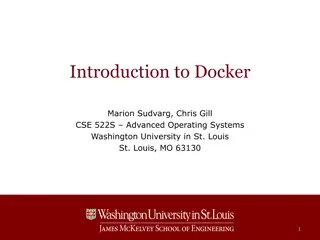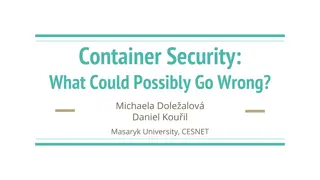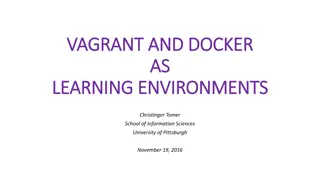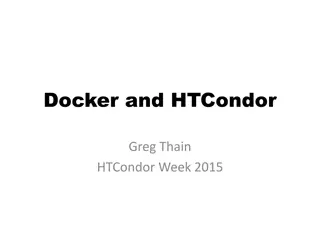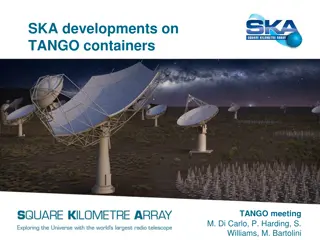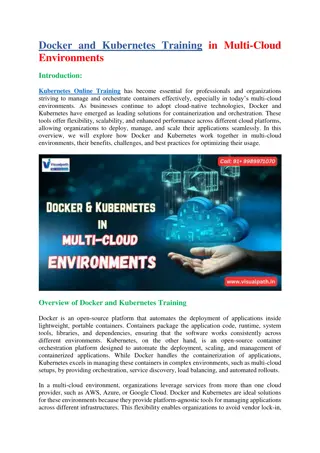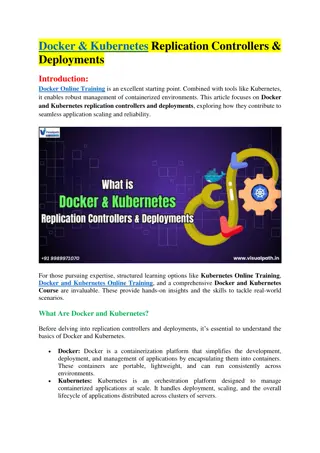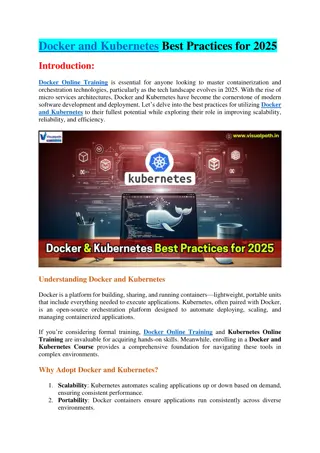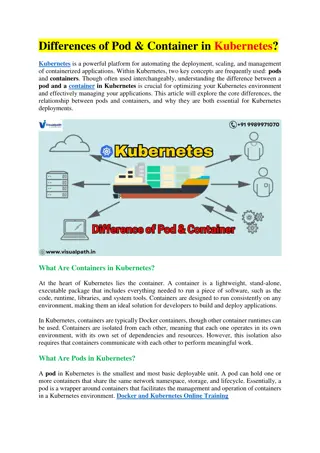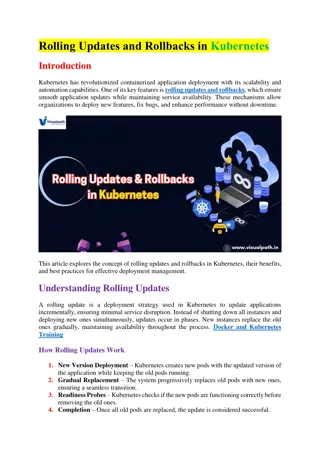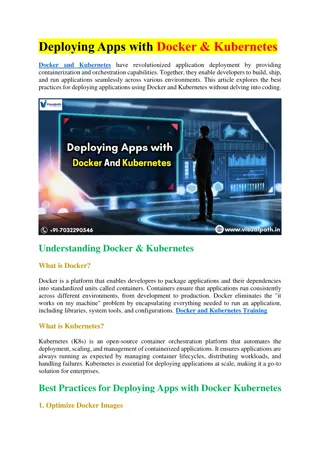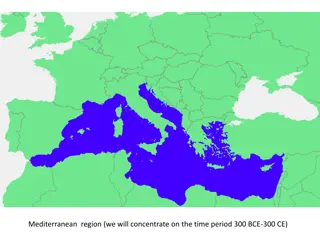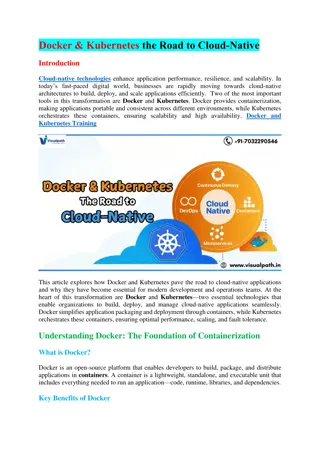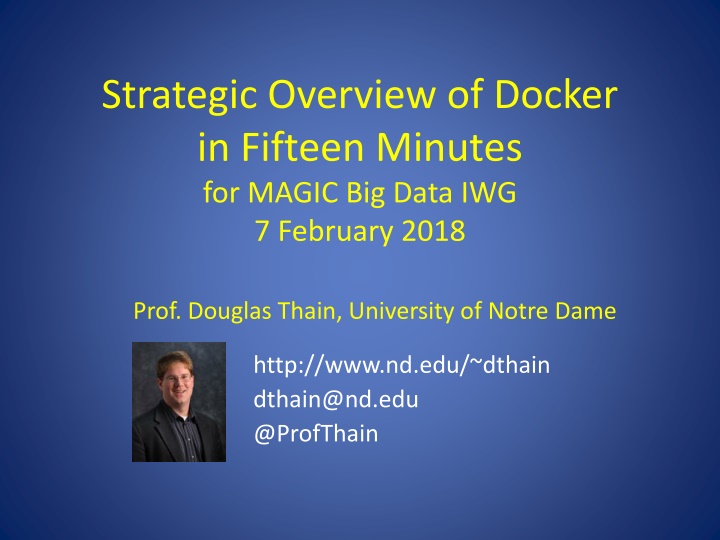
Docker: A Comprehensive Overview
Dive into the world of Docker with a concise overview covering its structure, functionalities, ecosystem, and more, explained in an easy-to-understand manner. Learn about container sub-structure, Docker Swarm dynamics, and how Docker containers are revolutionizing the industry.
Download Presentation

Please find below an Image/Link to download the presentation.
The content on the website is provided AS IS for your information and personal use only. It may not be sold, licensed, or shared on other websites without obtaining consent from the author. If you encounter any issues during the download, it is possible that the publisher has removed the file from their server.
You are allowed to download the files provided on this website for personal or commercial use, subject to the condition that they are used lawfully. All files are the property of their respective owners.
The content on the website is provided AS IS for your information and personal use only. It may not be sold, licensed, or shared on other websites without obtaining consent from the author.
E N D
Presentation Transcript
Strategic Overview of Docker in Fifteen Minutes for MAGIC Big Data IWG 7 February 2018 Prof. Douglas Thain, University of Notre Dame http://www.nd.edu/~dthain dthain@nd.edu @ProfThain
Container Overview Container (Active) Image (Passive) Build Script (Dockerfile) Private Filesystem FROM parent-image WORKDIR /data ADD mydata /data RUN yum install mysim EXPOSE 8080 CMD [ "mysim", . . . ] Resource Limits Portable Filesystem in a Single File run build Namespaces: pid/net/ipc/mn/uts Purpose: To provide independent applications with the ability to define private, customized environments that are easily distributable.
Docker Structure (access control) (root) dockerd docker (user) Running Containers Image Store Containers: run create attach ps cp commit start/stop rm Images: images pull / push build rmi load / save MyDatabase MyWebserver push/pull Docker Hub
Container Sub-Structure Kernel Storage Driver Appl r/w Device Mapper AUFS OverlayFS Writeable Scratch Layer Running Container 3986ab + Data Passive Image Dockerfile: FROM rhel7.2 RUN yum install myexe COPY mydata /data e7b38ac + Application abcf1234 Base OS Layer
Encourage De-Duplication Writeable Scratch Layer Writeable Scratch Layer Writeable Scratch Layer + Data A (100MB) + Data B (200MB) + Data C (1GB) + Appl A (10MB) + Appl B (20MB) Base OS Layer (10GB)
Docker Compose (Static) Common case: a web-service that consists of multiple concurrent services. Database Webserver Memcached DF IMG CNT DF IMG CNT DF IMG CNT docker-compose build myservice.yml docker-compose up myservice.yml myservice.yml Persistent state is outside the cluster. Requires external supervision to maintain.
Docker Swarm (Dynamic) Worker WWW Worker WWW Worker Manager Swarm RAFT Consensus State Manager Worker $$$ Worker $$$ Worker $$$ Manager Worker DB Worker DB Worker DB create service www (2) create service memcached (3) create service database (2) Persistent state is inside the cluster. Once created, self-maintaining.
Docker Ecosystem Docker containers are used widely in industry and have become an interchange format. Google GCE, Amazon ECS, Mesos, Kubernetes all support Docker container execution. (But not necessarily using Docker per se.) Running your own container cluster is rather challenging! One opinion: https://thehftguy.com/2016/11/01/docker-in-production-an- history-of-failure/
Problem: Garbage Collection Problem: Any authenticated user can consume storage by create/pulling new images, and nothing removes them automatically. Any automated activity will eventually consume all storage and wedge docker. A cronjob seems to be the community solution: docker images q a | xargs no-run-if-empty docker rmi However, this doesn't take into account containers that are "needed" even if not currently run. Effective use requires one of several ideas: Use a small number of containers widely. Trust users to delete unneeded containers. Make use cases robust to periodic removal.
Problem: Adding Docker to HPC Idea sounds simple: You already have a batch system, just put Docker on every node. Very challenging to get this right: Docker has very specific kernel requirements, consumes large amounts of local space, resources conflict with each other, independent scheduling. Underlying challenge: Docker really wants to be your core resource manager. It's fighting with the ones you already have: batch system, parallel file system.. (Shifter, Singularity, CharlieCloud, and others are working to address this space directly.)
Takeaways Designed for deploying micro services, which is different than executing HTC/HPC jobs. Docker container format is now standard. Docker works very well within its own ecosystem, but is quite difficult to integrate into existing facilities. Garbage collection remains unsolved prob. Very sensitive to underlying kernel tech.
Container Portability In Makeflow Wharf: Containers on Shared Filesystems dockerd A dockerd B Cont. Store Cont. Store Shared Image Store Task Task Task Docker Singularity Data Data Data MDS RHEL6 RHEL7 SLES8 Parallel Filesystem
http://ccl.cse.nd.edu @ProfThain


